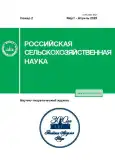Simulation of degradation of pasture ecosystems of arid zone
- Autores: Salugin A.N1
-
Afiliações:
- Federal Scientific Centre of Agroecology, Complex Melioration and Protective Afforestation of the Russian Academy of Sciences
- Edição: Nº 2 (2023)
- Páginas: 7-10
- Seção: Articles
- URL: https://journals.rcsi.science/2500-2627/article/view/144596
- DOI: https://doi.org/10.31857/S2500262723020023
- EDN: https://elibrary.ru/AOMXGY
- ID: 144596
Citar
Texto integral
Resumo
Sobre autores
A. Salugin
Federal Scientific Centre of Agroecology, Complex Melioration and Protective Afforestation of the Russian Academy of Sciences
Email: saluginan@mail.ru
400062, Volgograd, Universitetskij prosp., 97
Bibliografia
- Логофет Д.О, Маслов А.А. Анализ мелкомасштабной динамики двух видов-доминантов в сосняке чернично-бруснично-долгомошном II. Неоднородная Марковская цепь и осредненные показатели // Журн. общ. биологии. 2018. Т. 79. № 2. С. 135-147.
- Логофет Д.О, Уланова Н.Г. От мониторинга популяции к математической модели: новая парадигма популяционного исследования // Журн. общ. биологии. 2021. Т. 82. № 4. С. 243-269. doi: 10.31857/ S0044459621040035.
- Куст Г.С., Андреева О.В., Лобковский В.А. Нейтральный баланс деградации земель - современный подход к исследованию засушливых регионов на национальном уровне // Аридные экосистемы. 2020. Т.26. № 2 (83). С. 3-9. doi: 10.1134/S2079096120020092.
- Касталевский Д.Ю. Основы имитационного моделирования и системного анализа в управлении. М.: Издательский дом "Дело", 2015. 496 с
- Pykh Y.A. Lyapunov-Meyer functions and distance measure from generalized Fisher's equations // IFAC- PapersOnLine. 2015. No. 48 (11). P. 115-119.
- Князева Е.Н., Курдюмов С.П. Основания синергетики. Режимы с обострением, самоорганизация, темпомиры. СПб.: Алетейя, 2002. 414 с.
- Добровольский Г.В. Тихий кризис планеты // Вестник РАН. 1997. Т. 4. №. 67. С. 313-320.
- Петропавловский Б.С, Варченко Л.И. Использование информационной статистики для изучения экологии растительности и динамических процессов растительного покрова земли // Сибирский экологический журнал. 2021. № 28 (3). С. 263-273. doi: 10.15372/ SEJ20210301.
- Черкашин А.К, Бибаева А.Ю. Натурные и дистанционные исследования и математическое моделирование горностепных экосистем на ландшафтной основе // Аридные экосистемы. 2020. Т. 26. № 4 (85). С. 108-115. doi: 10.24411/1993-3916-2+020-10125.
- Миркин Б.М., Наумова Л.Г., Соломещ А.И. Современная наука о растительности: учебник. М.: Логос, 2002. 264 с.
- Vlasenko M.V, Kulik A.K., Salugin A.N. Evaluation of the ecological status and loss of productivity of arid pasture ecosystems of the Sarpa lowland // Arid Ecosystems. 2019. No. 9 (4). P. 273-281. doi: 10.1134/ S2079096119040097.
- Салугин А.Н, Власенко М.В. Аналитическое моделирование деградации аридных пастбищ // Известия Нижневолжского агроуниверситетского комплекса: Наука и высшее профессиональное образование. 2021. № 3 (63). С. 366-376. doi: 10.32786/2071-9485-2021-03-38.
- Виноградов Б.В. Основы ландшафтной экологии. М.: ГЕОС, 1998. 418 с.
- Салугин А.Н. Численное моделирование сукцессионных переходов в агроэкологии // Российская сельскохозяйственная наука. 2020. № 1. С. 62-65. doi: 10.31857/S2500-2627-2020-1-62-65.
- Salugin A.N., Vlasenko M.V. Mathematical models of the dynamic stability of arid pasture ecosystems in the south of Russia // Agronomy. 2022. No. 12 (6). P. 1448. URL: https://www.mdpi.com/2073-4395/12/6/(дата обращения: 10.03.2013). doi: 10.3390/agronomy12061448.
- Гусев А.П. Закономерности долговременной динамки локальных геосистем юго-востока Беларуси // Учёные записки Крымского федерального университета имени В. И. Вернадского. География. Геология. 2022. Т. 8 (74). № 2. С. 60-70.
- Обратный прогноз подтверждает вывод о жизнеспособности ценопопуляции растений / Д.О. Логофет, Е.С. Казанцева, И.Н. Белова и др. // Журн. общ. биологии. 2020. Т. 81. № 4. С. 257-271. doi: 10.31857/ S0044459620040041.
- Маслов А.А, Логофет Д.О. Совместная динамика популяций черники и брусники в заповедном послепожарном сосняке-зеленомошнике. Модель с осредненными вероятностями перехода // Журн. общ. биологии. 2020. Т. 81. № 4. С. 243-256. doi: 10.31857
Arquivos suplementares









